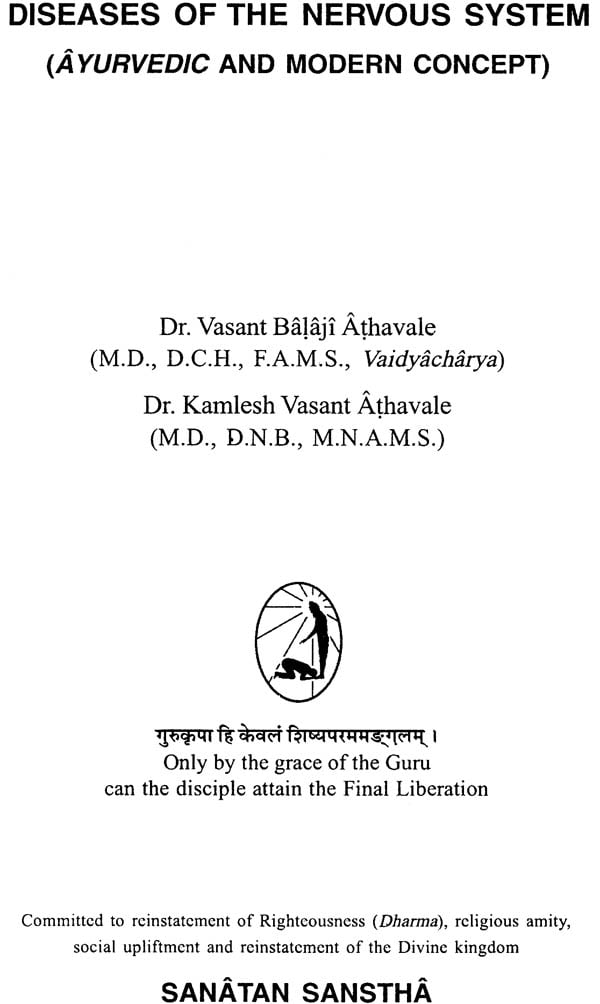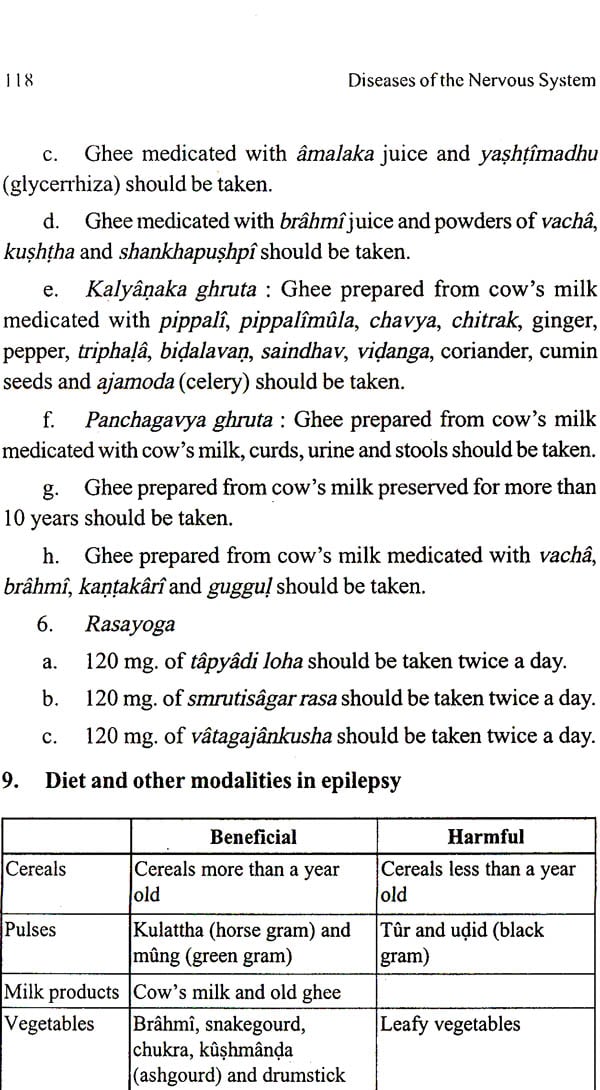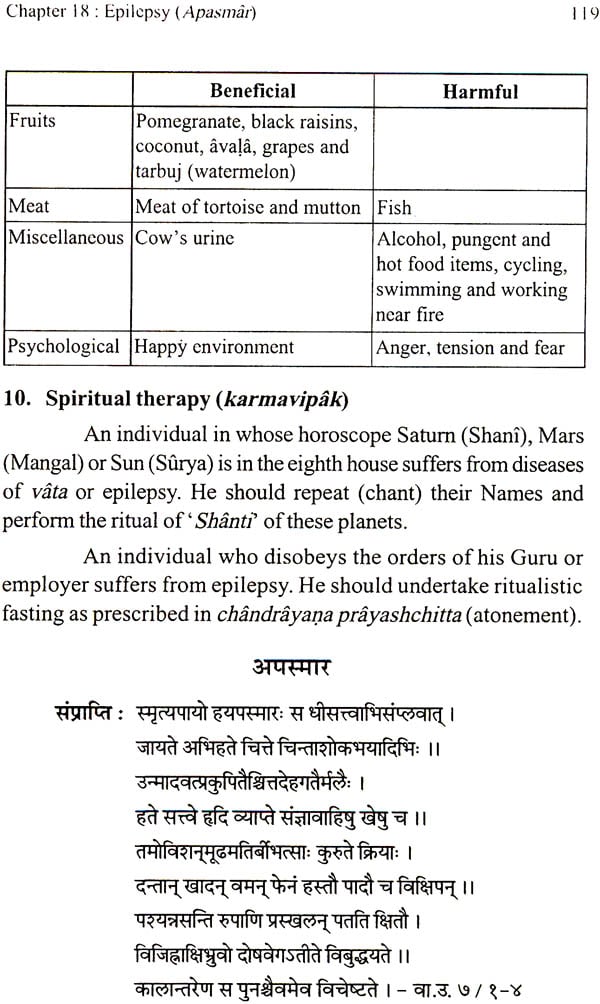
Diseases Of The Nervous System (Ayurvedic and Modern Concept)
Book Specification
| Item Code: | NAE052 |
| Author: | Dr.Vasant Balaji Athavale& Dr. Kamlesh Vasant Athavale |
| Publisher: | Sanatan Bharatiya Sanskriti Sanstha |
| Edition: | 2002 |
| ISBN: | 818049022X |
| Pages: | 214 (5 Color Illustrations) |
| Cover: | Paperback |
| Other Details | 8.5 inch X 5.5 inch |
| Weight | 240 gm |
Book Description

Dr. Vasant BáIáji Athavale. M.D. (Paediatrics), D.C.H., F.A.M.S., Vaidyacharya is a renowned paediatrician and an eminent author. He stood first in D.C.H. and in M.D. (Paediatrics). He was the founder of the Paediatric Department of the Lokmánya Tilak Municipal Hospital, Sion established in 1959 and was Head of the Department and Professor of Paediatrics for 30 years from 1959-1990. He was the editor of the Paediatric Clinics of India from 1971 to 1990. He was offered Unicef fellowship in 1965 for his paper read at the ‘International Paediatric Conference’ held in Tokyo. He was the chairman of the workshop on ‘Herbal Medicines for Health’ held in Bangkok in 1981.
Dr. Athavale holds the highest degree in Ayurveda, ‘Vaidyacharya. He has written several books on Ayurveda and has practically updated the entire Ayurveda through his books. These books in English and Mardthi are written in a lucid language and shall therefore be useful to Ayurvedic physicians as well as the common man. He was awarded the international award for the ‘Best author of Ayurvedic books’ in 1996. He was honoured with a ‘Lifetime Achievement Award’ by the RdhrIya Shikshau Mandal at the international seminar on Ayurveda in 2001.
Dr. Athavale has also written several books for parents which serve as an excellent guide for bringing up children.
Dr. Athavale accords the credit of all his achievements to his parents and teachers.
The second author of this hook, Dr. Kamlesh Athavale is the son of Dr. V. B. Athavale. He passed his M.D. (Paediatrics), D.N.B.E. and M.N.A.M.S. with a brilliant academic record. He is a dedicated paediatrician and has completed his fellowship in Neonatology from U.S.A.
He hits made significant contributions in writing these books.
The nervous system is the most evolved system and the brain is the most evolved organ in the body. The brain is the seat of the human mind. The mind controls the entire body through the brain and the nervous system. The mind, brain and body work in co-ordination with one another. Any disturbance in one affects the other two. These three are in continuous link with one another through ‘vâyu tanmátrã’ which are the nerve impulses transmitted through the nerves- Hence vataroga that is diseases of the väta humour (dosha) include diseases of the mind, brain, nervous system, nerves and muscles.
The nerve cells called neurons are the most evolved cells in the body. The other cells can regenerate by cell division, however the neurons cannot. New neurons are formed only up to five months after birth. For the rest of our life, the number of neurons remains constant. If neurons die due to injury, infection, degeneration or any other reason, they cannot be replaced by new neurons. Hence in diseases of the nervous system, the patient does not recover completely and many of these diseases are incurable.
In a patient suffering from heart, liver or kidney diseases, the affected organs can be replaced with the organs of a donor who may have met with an accidental death. The organs should be removed immediately after the death of the donor and transplanted into the pa4ient’s body. However this is not possible in the case of the brain as the nerve plexus is distributed throughout the body. Even if it were possible to transplant the brain of a deceased person in a living person with a diseased brain, it would create several new problems as the mind and the personality would be those of the deceased person while the body would be that of the living person.
In this book, the functions and diseases of the mind, brain, nervous system, nerves and muscles are discussed from the Ayurvedic point of view. This book will be useful to doctors, vaidyas, medical students, nurses and others. We pray to The Almighty to bestow everyone with a healthy mind and nervous system and a long, happy, healthy and prosperous life.
| 1 | Man and the universe | 21 |
| 2 | Diseases of the vflta humour (ciosha) | 29 |
| 3 | Intelligence | 45 |
| 4 | Down’s syndrome (Mongolism) | 60 |
| 5 | Headache (shiroroga) | 61 |
| 6 | Sleep, insomnia and dreams | 73 |
| 7 | Atatvâbhinivesha, incoherent talk, intoxication, giddiness and drowsiness | 78 |
| 8 | Insanity (unmâd) | 83 |
| 9 | Fainting (mürchçhi) Causes | 89 |
| 10 | Crying in children | 94 |
| 11 | Hysteria | 99 |
| 12 | Hydrocephalus | 102 |
| 13 | Meningomyclocoele | 104 |
| 14 | Cerebral palsy | 105 |
| 15 | Head injury | 107 |
| 16 | Meningitis | 108 |
| 17 | Encephalitis | 110 |
| 18 | Epilepsy (apasmâr) | 113 |
| 19 | Convulsions in newborn babies | 121 |
| 20 | Febrile convulsions | 123 |
| 21 | Breath holding spasms | 127 |
| 22 | Vâtai-oga in locafised regions | 128 |
| 23 | Hemiplegia pakshâghâ I ardhânga vâtal | 134 |
| 24 | Facial palsy (ardita) | 137 |
| 25 | Paraplegia (paralysis of both the lower limbs) | 140 |
| 26 | Defective sense of taste and touch and wasting of muscles of the upper limbs (bflhushoha) | 141 |
| 27 | Diseases of the muscles | 142 |
| 28 | Classification of diseases caused by the three humotirs (doshas) | 147 |
| 29 | Dhâtugata vâta | 156 |
| 30 | Avruta vita | 158 |
| 31 | The best measure and medicine | 173 |
| 32 | Preparation of A vun’edic recipes | 175 |
| Bibliography | 198 |







